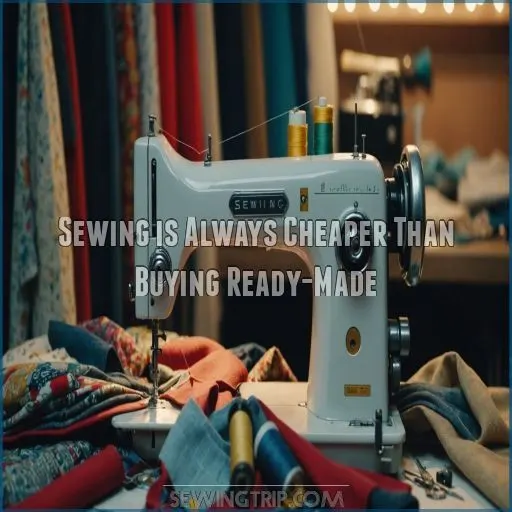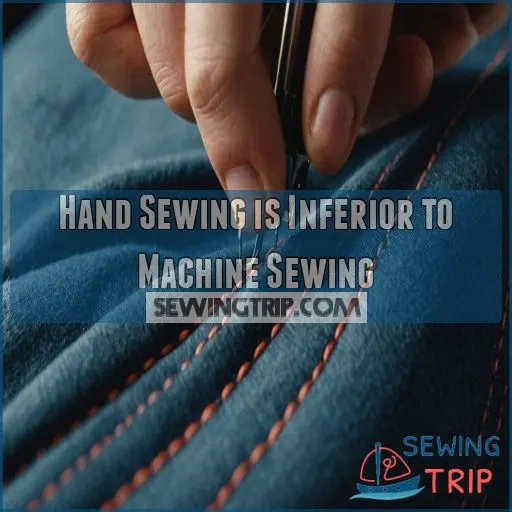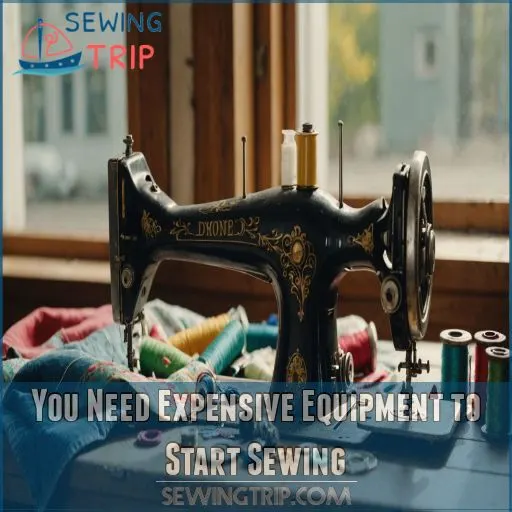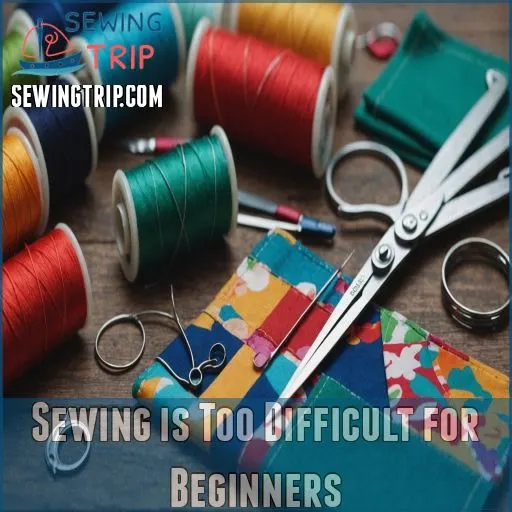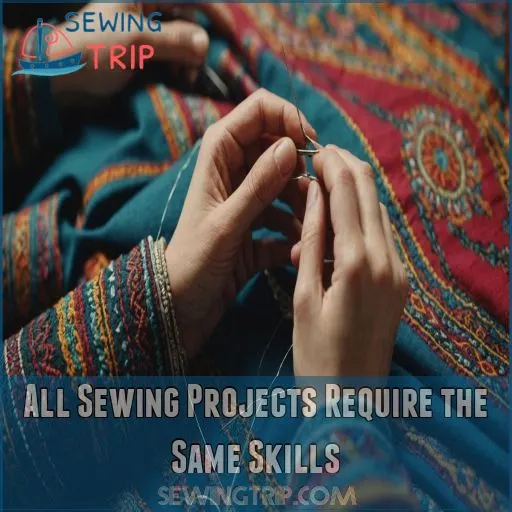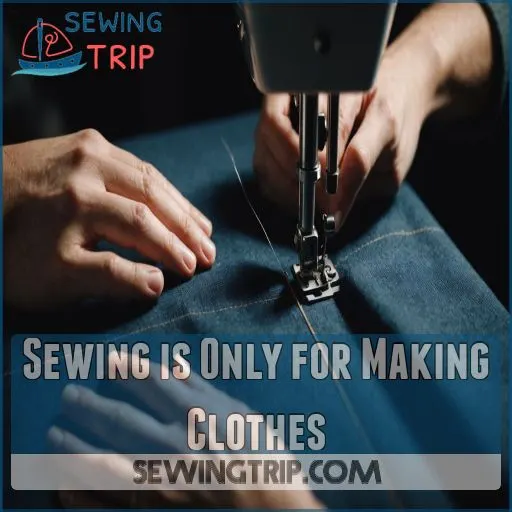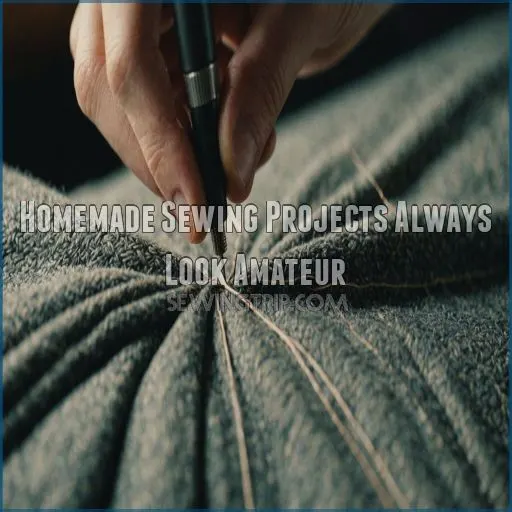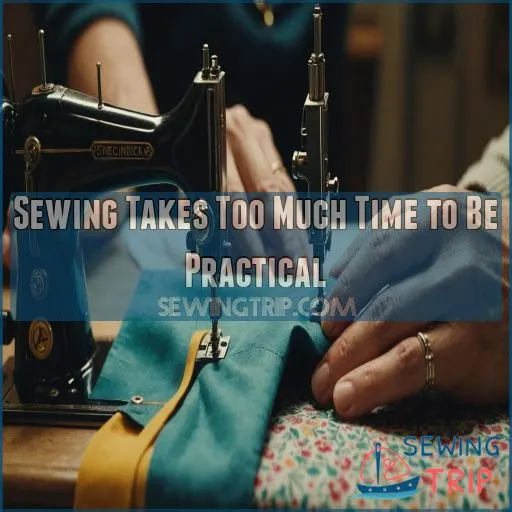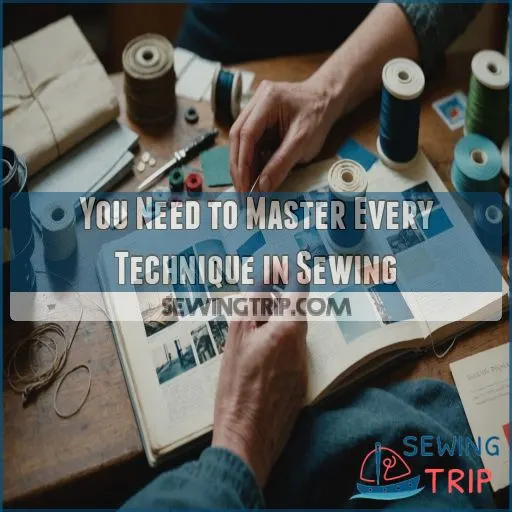This site is supported by our readers. We may earn a commission, at no cost to you, if you purchase through links.
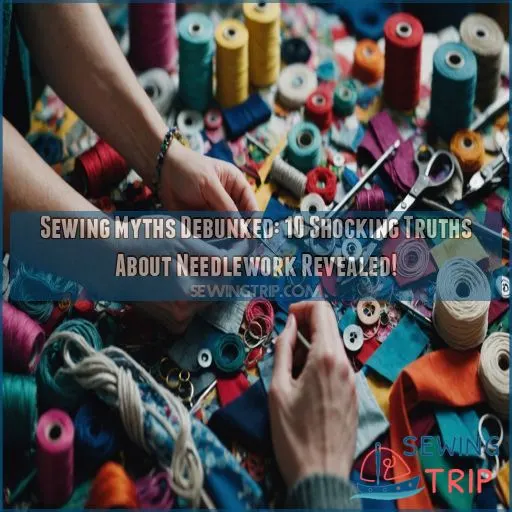
Contrary to popular belief, sewing isn’t just for grandmas, and it’s not always cheaper than buying ready-made clothes.
You don’t need a fortune to start either – basic equipment can be surprisingly affordable.
Hand sewing isn’t inferior to machine work; it’s actually preferred in haute couture.
And no, you can’t whip up a prom dress in an afternoon (unless you’re a wizard with a needle).
Sewing myths debunked? You bet. It’s a skill that’s both practical and creative, offering endless possibilities for customization and self-expression.
Ready to unravel more sewing secrets?
Table Of Contents
- Key Takeaways
- Sewing is Always Cheaper Than Buying Ready-Made
- Hand Sewing is Inferior to Machine Sewing
- You Need Expensive Equipment to Start Sewing
- Sewing is Too Difficult for Beginners
- All Sewing Projects Require the Same Skills
- You Can’t Sew Stretch Fabrics Without Special Machines
- Sewing is Only for Making Clothes
- Homemade Sewing Projects Always Look Amateur
- Sewing Takes Too Much Time to Be Practical
- You Need to Master Every Technique in Sewing
- Frequently Asked Questions (FAQs)
- Conclusion
Key Takeaways
- You don’t need to break the bank to start sewing. Contrary to popular belief, basic equipment can be surprisingly affordable. Start with simple tools and gradually build your sewing arsenal as your skills grow. Remember, it’s not the fancy gadgets that make the seamstress, but the passion and practice you put in.
- Hand sewing isn’t inferior to machine sewing – it’s a different skill altogether, as the article on handheld sewing machines points out. In fact, haute couture houses often prefer hand stitching for its precision and control. So don’t look down on your needle and thread; they might just be your secret weapons for creating truly unique pieces.
- Sewing isn’t just for whipping up clothes. From cozy quilts to stylish home decor, your sewing skills can transform your living space and unleash your creativity in unexpected ways. Who knew you could stitch up a storm without ever touching a pair of pants?
- You don’t need to master every technique to create amazing projects, like learning to fabric paint on denim. Focus on learning the specific skills for your current project, and you’ll gradually build your sewing repertoire over time. It’s like cooking – you don’t need to be a master chef to whip up a delicious meal.
Sewing is Always Cheaper Than Buying Ready-Made
You’ve probably heard that sewing your own clothes is always cheaper than buying them off the rack.
But hold onto your needles, because this common belief isn’t always true – there’s more to the cost equation than meets the eye!
Cost Comparison of Materials and Production
You’ve probably heard that sewing your own clothes is always cheaper, but hold onto your pincushions! The truth might surprise you.
While DIY can save you money, it’s not always a bargain bonanza. Manufacturers enjoy bulk discounts on fabric and materials that you can’t match.
Plus, their streamlined production methods often result in lower labor costs. Your homemade masterpiece might end up costing more than you think!
Quality and Durability of Handmade Vs. Mass-Produced
When you compare handmade vs. mass-produced garments, you’ll uncover a surprising truth.
While store-bought clothes might seem cheaper at first glance, handmade items often boast superior quality and longevity.
Your lovingly crafted pieces, sewn with care and attention to detail, can outlast their factory-made counterparts by years.
Plus, you’re in control of ethical production and environmental impact, making each stitch a step towards sustainability.
Time Investment and Skill Level Considerations
Time is money, and sewing projects can be major investments. When considering the cost-effectiveness of sewing, factor in your skill level and the project’s complexity. Here’s what to keep in mind:
- Beginners may need more time to complete projects
- Simple items like pillowcases are quicker than custom suits
- Your speed will improve with practice
- Complex designs require more time and patience
- Time spent sewing can be enjoyable and stress-relieving
Hidden Costs in Home Sewing Projects
While considering time and skill, don’t forget the hidden costs of home sewing.
Materials can add up quickly, especially when you’re learning.
Those fancy scissors, specialized needles, and that irresistible fabric? They’ll make a dent in your wallet.
Plus, mistakes happen – we’ve all sewn a sleeve on backwards!
Factor in these extras when comparing costs, and you might be surprised at the true price of your DIY duds.
Long-Term Value of Customized Garments
Although the initial cost may be higher, customized garments offer incredible long-term value.
You’ll enjoy clothes that fit like a glove and reflect your unique style.
These personalized pieces often become cherished favorites, standing the test of time both in durability and sentiment.
Plus, you’re investing in sustainable fashion that won’t end up in the donation pile after a few wears.
It’s like having a tailor-made wardrobe that keeps on giving!
Hand Sewing is Inferior to Machine Sewing
You might think hand sewing is outdated, but it’s far from inferior to machine sewing.
Hand sewing offers unique advantages that even high-end fashion houses rely on for their most exquisite creations.
Historical Longevity of Hand-Sewn Garments
You might think machine-sewn garments are superior, but historical evidence tells a different story.
Hand-sewn clothes from centuries ago still exist today, showcasing incredible durability.
Ever wonder why museums house ancient textiles? It’s the careful hand-stitching that’s kept them intact.
By mastering vintage techniques, you’re not just sewing – you’re creating potential heirlooms.
Imagine your great-grandchildren admiring your handiwork decades from now.
Now that’s a stitch in time!
Haute Couture Reliance on Hand Sewing
Contrary to popular belief, hand sewing isn’t inferior to machine sewing in haute couture, even with the handheld sewing machines available today. The world’s most prestigious fashion houses rely heavily on hand-stitching for their luxury garments. It’s not just about tradition; hand sewing offers unparalleled control and finesse.
Here’s why couturiers swear by it:
- Precision in intricate details
- Ability to work with delicate materials
- Customization for perfect fit, like hemming suit pants, is key to a flattering look
You’re not just sewing; you’re crafting wearable art that stands the test of time.
Advantages of Hand Sewing for Delicate Fabrics
While machines excel in many areas, hand-sewing shines for delicate fabrics. Ever tried to machine-sew chiffon? It’s like herding cats! Hand-stitching gives you unparalleled control, allowing for invisible seams and preserving the fabric’s integrity.
It’s perfect for those gossamer-thin silks or vintage laces that would disintegrate under a machine’s feed dogs.
Plus, there’s something deeply satisfying about crafting couture-level details with your own two hands.
Strength and Flexibility of Properly Executed Hand Stitches
Properly executed hand stitches pack a powerful punch.
Don’t let their delicate appearance fool you – these tiny titans can withstand the test of time.
Historical garments stitched by hand have survived centuries, proving their durability.
In fact, haute couture houses still rely on hand sewing for their most luxurious creations.
The secret? Hand stitches offer unparalleled strength and flexibility, adapting to the body’s movements like a second skin.
Aesthetic Value of Hand-Sewn Details
You might think machine-made garments are sleeker, but hand-sewn details add a touch of magic.
Ever noticed those tiny, perfect stitches on a couture gown? That’s the mark of true craftsmanship.
Hand-sewn finishes elevate your creations from ordinary to extraordinary. They’re not just functional; they’re little works of art.
Imagine wearing a custom-made garment with visible stitching that tells a story – that’s the beauty of hand-sewn details.
You Need Expensive Equipment to Start Sewing
Think you need to break the bank to start sewing?
Think again!
You’ll be surprised to learn that getting started with sewing is more affordable than you might imagine, with plenty of budget-friendly options for beginners.
Affordable Options for Beginner Sewing Machines
Starting your sewing journey doesn’t require breaking the bank.
Contrary to popular belief, there’s a world of budget-friendly sewing machines waiting for you.
From basic models under $100 to feature-packed options around $200, you’ll find plenty of choices.
Consider key features like stitch variety and ease of use.
Don’t overlook second-hand machines either – they’re often hidden gems for beginners looking to dip their toes into stitching.
Essential Tools for Novice Sewers
While affordable sewing machines are great, let’s talk about the real MVPs of your sewing kit.
Contrary to popular belief, you don’t need a fortune to gather the essentials.
Here’s what every novice sewer should have in their toolbox:
- Sharp fabric scissors
- Measuring tape
- Straight pins and a pincushion
These basic tools will set you up for success without breaking the bank.
Gradual Investment in Advanced Equipment
Now that you’ve got the basics, let’s talk smart upgrades. Building your sewing arsenal doesn’t mean emptying your wallet overnight. Think of it as a sewing adventure – you’ll add new tools as you grow. Here’s a roadmap for gradually expanding your sewing setup:
| Stage | Equipment to Add | Estimated Cost |
|---|---|---|
| Beginner | Basic machine, scissors, pins | $150 – $300 |
| Intermediate | Serger, rotary cutter, mat | $300 – $600 |
| Advanced | Coverstitch, dress form | $500 – $1000 |
| Expert | Embroidery machine, specialized feet | $1000+ |
| Pro | Industrial machines, software | $2000+ |
Building your sewing arsenal doesn’t mean emptying your wallet overnight. Think of it as a sewing adventure – you’ll add new tools as you grow. Here’s a roadmap for gradually expanding your sewing setup:
Importance of Skill Over Machine Capabilities
Even though fancy machines boast impressive features, it’s your skills that truly make the magic happen.
You don’t need a top-of-the-line model to create beautiful projects.
Instead, focus on mastering sewing fundamentals.
As you practice, you’ll find that your growing expertise trumps any high-tech gadgetry.
Alternatives to Purchasing New Equipment
You don’t need to break the bank to start sewing.
Think outside the box!
Borrow equipment from friends or family, or join a local sewing group.
Repurpose household items for DIY tools – a wine bottle makes a great seam roller!
Scour thrift stores for secondhand machines and supplies.
Online resources like YouTube tutorials can teach you techniques without expensive classes.
With a little creativity, you’ll be stitching up a storm in no time!
Sewing is Too Difficult for Beginners
You might think sewing is a complex skill reserved for the crafty elite, but that’s far from the truth.
Sewing is an accessible hobby that anyone can pick up with a little patience and practice, offering a world of creative possibilities right at your fingertips.
Simple Projects for Building Confidence
Think sewing’s too hard? Let’s squash that myth!
Starting with simple projects is your ticket to success.
Try whipping up a pillowcase or tote bag – these quick wins will boost your confidence in no time.
No need for fancy equipment; just grab some fabric, thread, and basic tools.
Before you know it, you’ll be stitching up a storm and feeling like a pro!
Progression of Skills Through Practice
Building confidence with simple projects is just the beginning.
As your skills grow, so will your ambition.
The sewing journey is a thrilling adventure of constant improvement.
Here’s how your skills will progress:
- Mastering straight lines becomes second nature
- Curves and corners start feeling like a breeze
- Complex patterns transform from challenging to doable
Common Misconceptions About Sewing Complexity
Now that we’ve seen how skills progress, let’s tackle some common myths about sewing complexity.
Many believe sewing is akin to rocket science, but that’s far from the truth!
The idea that you need to be a mathematical genius or have superhuman patience is simply nonsense.
In reality, sewing is a craft that anyone can learn with a bit of practice and perseverance.
It’s all about taking those first stitches!
Benefits of Starting With Easy Projects
While sewing might seem intimidating at first, starting with easy projects is your secret weapon for success.
You’ll build confidence as you tackle simple tasks, gradually honing your skills without feeling overwhelmed.
By choosing beginner-friendly projects, you’ll debunk the myth that sewing is too complex.
Before you know it, you’ll be stitching up a storm and wondering why you ever hesitated to start!
All Sewing Projects Require the Same Skills
You might think all sewing projects are cut from the same cloth, but that’s far from the truth.
Each project demands its own unique set of skills and techniques, whether you’re stitching a simple pillowcase or crafting a couture gown.
Variety of Techniques Across Different Projects
You’ve conquered your first project, but don’t think all sewing is created equal! Each new endeavor brings its own set of challenges and techniques. Whipping up a tote bag won’t prepare you for tailoring a suit.
From delicate silks to sturdy denims, every fabric type demands different handling.
Your trusty straight stitch might suffice for pillowcases, but intricate embroidery or quilting? That’s a whole new ballgame!
Specialization in Specific Areas of Sewing
As you explore different sewing projects, you’ll discover that each niche has its own set of specialized skills.
Think of it like becoming a master chef – you might excel at pastry but struggle with sushi.
In sewing, couture techniques differ vastly from quilting.
Don’t feel pressured to be a jack-of-all-trades; instead, focus on honing the skills that align with your passion and projects.
Transferable Skills Between Different Types of Sewing
Many sewing skills are like Swiss Army knives – versatile and adaptable across different projects.
Basic stitches, fabric handling, and pattern reading are your foundation, whether you’re whipping up a dress or quilting a masterpiece.
Machine operation and seam finishes translate well too.
Don’t fret if you’re a pro at hemming pants but novice at embroidery. Your existing skills are a springboard, making new techniques easier to grasp.
Continuous Learning in Sewing Crafts
Sewing’s continuous learning curve keeps your skills sharp and your projects exciting.
Don’t let the myth that all sewing requires the same skills hold you back.
Check out online tutorials, join sewing communities, and share your projects to learn new techniques.
Each stitch is a step toward mastery, whether you’re crafting a simple tote or tackling a couture gown.
You Can’t Sew Stretch Fabrics Without Special Machines
You might think you need a fancy serger to tackle those stretchy fabrics, but here’s a secret: your trusty home sewing machine can handle them just fine, if you choose the right features.
With a few simple tricks and the right know-how, you’ll be whipping up comfy leggings and snug t-shirts in no time.
Techniques for Sewing Stretch Fabrics on Standard Machines
You don’t need a fancy serger to sew stretch fabrics! Your trusty standard machine can handle these tricky materials with a few clever tricks up your sleeve.
Here’s how you can tame those stretchy beasts:
- Use a zigzag or stretch stitch
- Adjust your tension for a balanced stitch
- Let the fabric guide itself – don’t pull or push
Essential Tools for Working With Stretchy Materials
Despite the myth, sewing stretch fabrics doesn’t require special machines.
With the right tools, your standard sewing machine can handle these tricky materials.
Equip yourself with stretch fabric needles, a walking foot, and elastic thread.
Don’t forget to test your fabric’s stretch percentage before diving in.
While a serger or overlock machine can be handy, they’re not essential for creating beautiful, stretchy garments at home.
Adjusting Machine Settings for Stretch Fabrics
Now that you’ve got your tools ready, let’s tweak those machine settings for stretch fabrics. It’s like finding the perfect dance partner for your stretchy material. Here’s how to make your regular machine play nice with elastic fabrics:
- Switch to a stretch stitch or narrow zigzag
- Loosen your upper thread tension slightly
- Use a ballpoint or stretch needle
- Adjust presser foot pressure if possible
With these adjustments, you’ll be stretching the truth about needing special machines!
Common Challenges and Solutions in Stretch Sewing
Stretch fabrics can be tricky, but don’t let them pull the wool over your eyes! Common challenges include wavy seams and skipped stitches.
To overcome these, choose the right fabric, adjust your machine settings, and use proper seam finishes.
Control tension carefully and select the appropriate needle.
With practice, you’ll be stretching your sewing skills in no time, creating comfortable and stylish garments without breaking a sweat.
Advantages of Specialized Machines for Stretch Fabrics
While standard machines can handle stretch fabrics, specialized ones like sergers or overlockers offer distinct advantages.
They create professional-looking seams, trim excess fabric, and finish edges all in one step.
You’ll find these powerhouses particularly useful for knits and activewear.
But don’t feel pressured to invest right away – your trusty sewing machine can still work wonders with the right techniques and a bit of practice.
Sewing is Only for Making Clothes
Think sewing’s just for whipping up clothes? You’re in for a surprise! From cozy quilts to stylish home decor, sewing opens up a world of creative possibilities beyond your wardrobe.
Diverse Applications of Sewing Skills
You’ve mastered sewing stretch fabrics, but did you know your skills can open up a world beyond clothing? Sewing isn’t just about stitching up a new dress. Your needle and thread are the keys to a treasure trove of creative possibilities. Let’s bust this myth wide open!
Here are three unexpected ways to put your sewing skills to work:
- Upcycle old jeans into a trendy tote bag
- Craft personalized DIY gifts for friends and family
- Repair and customize your favorite garments for a unique style
Home Decor and Soft Furnishings
Sewing isn’t just for filling your closet!
Let’s talk about sprucing up your living space.
With a needle and thread, you can transform your home into a cozy haven.
From DIY curtains to custom throw pillow covers, the possibilities are endless.
Check out these easy projects to get started:
| Project | Difficulty | Time Needed |
|---|---|---|
| Throw pillows | Easy | 1-2 hours |
| Curtain panels | Medium | 3-4 hours |
| Tablecloth | Easy | 2-3 hours |
Ready to make your home uniquely yours?
Crafting and Quilting Projects
Your sewing machine’s potential extends far beyond clothing.
Explore the world of crafting and quilting, where fabric becomes your canvas for endless creativity.
From intricate quilt patterns to cozy blankets, you’ll discover a whole new range of possibilities.
Whether you’re machine quilting or embracing the meditative art of hand quilting, these projects offer a perfect blend of artistry and functionality.
So grab your quilting tools and let your imagination run wild!
Accessories and Functional Items
Ever wondered how versatile sewing can be? It’s not just about clothing!
Expand your creative horizons with these functional and fashionable projects:
- Stylish tote bags for eco-friendly shopping
- Cozy throw pillows to spruce up your living space
- Custom laptop sleeves for tech protection
- Trendy scarves and headbands for all seasons
Think outside the closet and let your imagination run wild. With a needle and thread, you’ll soon be crafting practical items that showcase your unique style.
Repair and Upcycling Applications
The versatility of sewing extends far beyond creating new garments.
You’ll be amazed at how your needle and thread can breathe new life into old favorites.
From patching up worn jeans to transforming outdated curtains into stylish tote bags, the possibilities are endless.
Don’t toss that torn shirt – with a bit of creativity and sewing know-how, you can turn potential trash into sustainable treasure.
Homemade Sewing Projects Always Look Amateur
You’ve probably heard that homemade sewing projects always look amateur, but that’s far from the truth.
With the right techniques and materials, your DIY creations can rival store-bought items and even surpass them in terms of quality and style.
Importance of Quality Materials in Final Appearance
Many sewists mistakenly believe that their projects will always look homemade.
However, the secret to a polished finish lies in your fabric choice.
Quality materials can transform your creations from amateur to professional in a heartbeat.
When selecting fabrics, consider:
- Fiber content and durability
- Drape and texture
- Color and pattern coordination
Don’t skimp on your materials – investing in good fabric will make your hard work shine.
Professional Finishing Techniques for Home Sewers
You’ve got the quality materials, now let’s elevate your game with pro-level finishes.
Want to know a secret? Couture-inspired touches can transform your projects from "meh" to "wow!"
Master invisible seams, perfect pressing, and delicate hand-stitching details.
These aren’t just fancy frills – they’re the hallmarks of high-end garments.
With practice, you’ll be crafting pieces that look straight off the runway.
Ready to become a fashion designer?
Impact of Proper Fit on Garment Perception
Fit is the secret sauce that transforms homemade garments from frumpy to fabulous.
When your clothes hug your curves just right, you’ll exude confidence and style.
It’s not about perfection, but about creating a flattering silhouette that makes you feel like a million bucks.
Don’t be fooled by off-the-rack sizing – your unique body deserves a custom fit that’ll turn heads and boost your sewing cred.
Customization Advantages of Handmade Items
While a perfect fit elevates any garment, handmade items offer unparalleled customization.
Your creations can be made to:
- Express your unique personality
- Flatter your body shape perfectly
- Incorporate special details you love
Imagine wearing a dress that fits like a glove and reflects your style. That’s the magic of sewing!
With practice, you’ll create pieces that look professional but also tell your story. It’s like being your own fashion designer!
Common Mistakes That Lead to Amateur Looks
Handmade doesn’t mean homely! Let’s tackle those pesky mistakes that scream "amateur hour." Ever wonder why your projects don’t quite measure up? Here’s the lowdown on five common blunders and how to fix them:
Poor fabric choice
Sloppy seam finish
Inadequate pressing
Ill-fitting garment
Wrong pattern pick
| Mistake | Fix |
|---|---|
| Poor fabric choice | Match fabric to project |
| Sloppy seam finish | Use proper finishing techniques |
| Inadequate pressing | Press as you go |
| Ill-fitting garment | Adjust patterns beforehand |
| Wrong pattern pick | Choose skill-level appropriate patterns |
Nail these basics, and you’ll be sewing like a pro in no time!
Sewing Takes Too Much Time to Be Practical
You might think sewing is a time-consuming hobby that’s not worth the effort, but that’s far from the truth.
In fact, many sewing projects can be quick and practical, offering a fun way to create unique items while developing valuable skills.
Time-Saving Techniques for Efficient Sewing
Time is money, and sewing doesn’t have to eat up your precious hours. You can streamline your projects with nifty time-saving tools and clever shortcuts.
Start by planning your project thoroughly and prepping all materials beforehand.
Embrace batch sewing for similar items, and master efficient cutting techniques. Don’t shy away from using fusible interfacing or pre-made bias tape.
Quick and Easy Sewing Project Ideas
Contrary to popular belief, sewing doesn’t have to eat up your entire day. You’d be surprised how many quick projects you can whip up in no time! Grab some fabric scraps and create a stylish tote bag or cozy pillow cover in just an hour.
Upcycled crafts are perfect for beginners – transform old jeans into a trendy apron or turn a vintage tablecloth into chic placemats. The possibilities are endless!
Balancing Time Investment With Project Complexity
The key to efficient sewing lies in balancing your time investment with project complexity.
You don’t need to tackle a wedding dress on day one!
Start small and work your way up.
As you gain experience, you’ll learn to gauge project scope and set realistic goals.
Smart project planning helps you manage your time effectively, ensuring your sewing hobby fits seamlessly into your busy life.
Long-Term Benefits of Sewing Skills
While balancing project complexity, you’re also building a valuable skill set.
Learning to sew isn’t just about finishing one project; it’s an investment in your future.
You’ll save money on repairs, create unique gifts, and even start a side hustle.
Plus, you’re joining a rich tradition of craftsmanship.
Sewing as a Productive Hobby and Stress Reliever
Diving into sewing, you’ll find it’s far more than just a time-consuming chore. It’s a productive hobby that doubles as a stress reliever.
Embrace mindful stitching and discover its benefits:
- Boosts creativity and self-expression
- Improves focus and concentration
- Provides a sense of accomplishment
You’ll be amazed at how quickly you can whip up a project while enjoying some ‘me time’. It’s not just about the end product; it’s about the journey of self-care and mastery.
You Need to Master Every Technique in Sewing
You don’t need to be a sewing expert to create amazing projects.
Focus on learning the specific skills for your current project.
You’ll gradually build your sewing repertoire over time.
Focus on Project-Specific Skills
You don’t need to be a jack-of-all-trades in sewing.
Instead, zero in on skills that match your current projects.
Want to make a cozy quilt? Focus on patchwork techniques.
Dreaming of a fitted blazer? Hone your fitting skills.
By targeting specific abilities, you’ll save time and energy while still creating stunning pieces.
Gradual Skill Development in Sewing
Countless novice sewers believe they need to master every technique right away.
Don’t fall into this trap!
Sewing skills develop gradually, like building blocks.
Start with basic projects and simple patterns, then progressively tackle more complex challenges.
As your confidence grows, you’ll naturally expand your repertoire.
Embrace the journey and enjoy watching your skills blossom over time.
Importance of Foundational Techniques
While mastering every sewing technique isn’t necessary, building a solid foundation is key, like learning how to backstitch properly. Think of it like learning to cook – you don’t need to be a master chef, but knowing the basics opens up a world of possibilities.
Here are some fundamental skills that’ll set you up for success:
- Understanding seam allowances
- Identifying fabric types and their properties
- Mastering pressing techniques
- Learning basic hand-stitching styles
- Grasping pattern reading essentials
These skills are your sewing Swiss Army knife, ready for any project you tackle!
Specialization Vs. Generalization in Sewing
Building on your foundational skills, it’s time to think about your sewing path. Specializing in a niche or becoming a jack-of-all-trades? Both have their merits. Let’s break it down:
| Specialization | Generalization | Balanced Approach |
|---|---|---|
| Deep expertise | Versatility | Adaptability |
| Niche market | Broad appeal | Flexible skills |
| Mastery focus | Varied projects | Targeted learning |
Specializing in a niche allows you to develop deep expertise in a particular area, which can be very rewarding. It also allows you to target a specific market, which can be more profitable. However, it can also limit your options and make it more difficult to adapt to changing trends.
Becoming a jack-of-all-trades can be more versatile and allow you to take on a wider variety of projects. It can also make you more adaptable to changing trends. However, it can be difficult to develop deep expertise in any one area.
A balanced approach combines the best of both worlds. You can develop a core set of skills and then specialize in a few areas that you are passionate about. This can give you the best of both worlds: depth and breadth.
Continuous Learning and Improvement in Sewing Craft
You don’t need to be a jack-of-all-trades in sewing.
Instead, focus on honing skills that spark your passion.
Think of sewing as a lifelong journey – there’s always something new to learn!
Join sewing classes, jump into online tutorials, or connect with fellow enthusiasts.
As you grow, you’ll naturally expand your repertoire.
Embrace the learning process and watch your skills blossom!
Frequently Asked Questions (FAQs)
Is hand sewing almost always slower than machine sewing a true b false?
Hand sewing isn’t always slower than machine sewing. It’s a myth!
Your speed depends on skill level, project complexity, and fabric type.
For intricate details or delicate materials, hand sewing can actually be faster and more precise.
Is there science in sewing?
While some think sewing’s just about stitches, there’s a surprising amount of science involved.
From fabric physics to ergonomics, you’ll find chemistry in dyes, geometry in patterns, and even biology in natural fibers.
It’s a crafty blend of art and science!
How did people sew without sewing machines?
Before sewing machines, folks relied on nimble fingers and sharp needles.
They’d stitch by hand, using various techniques like running stitch or backstitch.
It was time-consuming but allowed for intricate designs and sturdy garments that could last generations.
Is sewing good therapy?
Ah, yes, sewing: the perfect therapy for those who enjoy stabbing things repeatedly!
But seriously, you’ll find it’s a great stress-buster.
You’re creating something beautiful while focusing your mind and keeping your hands busy.
It’s downright therapeutic!
Is it necessary to press every seam?
No, you don’t need to press every seam.
Some fabrics, like velvet, shouldn’t meet an iron at all.
Trust your judgment and the fabric’s needs.
Sometimes finger-pressing or skipping the iron altogether works just fine.
Can I sew without using patterns?
You can absolutely sew without patterns! It’s called "freehand sewing" or "draping."
You’ll need to understand basic garment construction, but it’s a great way to express your creativity and make truly unique pieces.
Give it a try!
Do I need to prewash all fabric?
Ah, the eternal dilemma: to wash or not to wash?
Don’t let your fabric pull a fast one on you.
Prewashing‘s a game-changer, preventing future shrinkage surprises.
It’s your secret weapon for perfect fits and long-lasting creations.
Is hand-finishing always better than machine finishing?
Hand-finishing isn’t always superior.
While it’s great for delicate fabrics and intricate details, machine finishing can be just as effective for many projects.
The best choice depends on your fabric, time, and desired outcome.
Experiment to find what works!
Are natural fibers always superior to synthetic ones?
Natural fibers breathe and feel luxurious.
Synthetic ones often boast durability and easy care.
It’s not a clear-cut choice; each has its strengths.
Consider your project’s needs and wear preferences when selecting fabrics.
Conclusion
There you have it, folks! We’ve unraveled these sewing myths like a loose thread on a vintage sweater.
Now that you’re armed with the truth, you can approach your next project with confidence.
Remember, sewing isn’t just for the experts or the penny-pinchers. It’s a versatile skill that anyone can learn and enjoy.
So don’t let these busted myths hold you back. Grab that needle and thread, and start creating!
Who knows? You might just stitch together a new passion.
Sewing myths debunked, creativity ignited!

